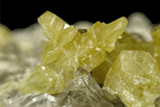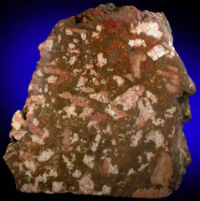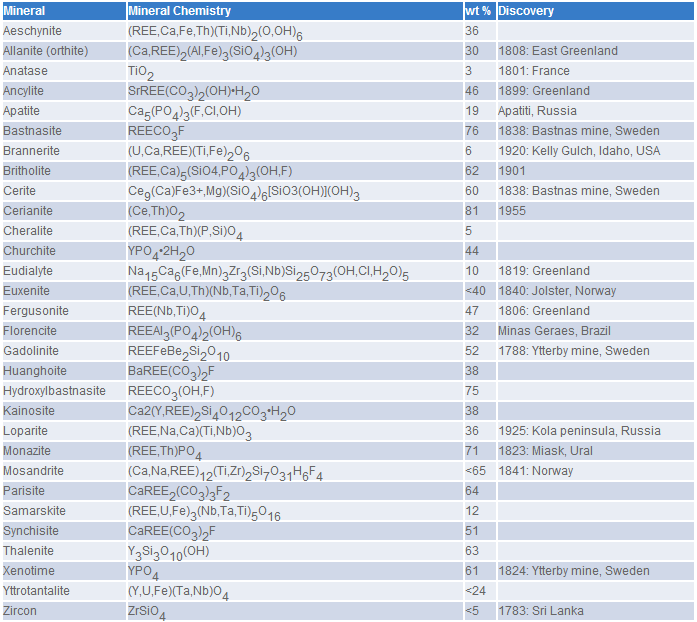- Rare earth minerals and classification
 In the earth’s crust, instead of existing as free metals, rare earth elements usually occur in the minerals of mixtures of various rare earth elements and nonmetals. More than 200 kinds of minerals have been discovered to contain essential or significant REE currently, and bastnaesite, monazite and xenotime are the three most economically significant of these.
In the earth’s crust, instead of existing as free metals, rare earth elements usually occur in the minerals of mixtures of various rare earth elements and nonmetals. More than 200 kinds of minerals have been discovered to contain essential or significant REE currently, and bastnaesite, monazite and xenotime are the three most economically significant of these. - Bastnaesite and monazite are the main sources of the light REEs, which account for about 95% of the REE currently used. Monazite is also the principal ore of thorium, containing up to 30% Th, together with smaller quantities of U, both with radioactive properties. Xenotime and minerals such as allanite are common sources of the heavy REE and yttrium.
 Bastnaesite occurs predominantly in calc-silicate rich rocks related to alkaline intrusive igneous complexes, in particular carbonatite. Monazite and xenotime are more common as accessory minerals in low-Ca granitoid rocks and pegmatites. Following weathering of these rock types, monazite and xenotime are concentrated in heavy mineral placer deposits because of their resistance to chemical attack and high specific gravity.
Bastnaesite occurs predominantly in calc-silicate rich rocks related to alkaline intrusive igneous complexes, in particular carbonatite. Monazite and xenotime are more common as accessory minerals in low-Ca granitoid rocks and pegmatites. Following weathering of these rock types, monazite and xenotime are concentrated in heavy mineral placer deposits because of their resistance to chemical attack and high specific gravity. - Other commercial sources of REE are apatite and loparite (western Russia), REE-bearing clays ("Longnan clay" or "southern ionic clay", Jiangxi Province, China), and various minerals such as allanite that are produced as a by-product of uranium mining (Canada). Of lesser importance are zircon (Th, Y and Ce) and euxenite. The main commercial source of scandium is as a by-product from the processing of uranium and tungsten.
- A list of common rare earth element bearing minerals is provided below. "REE" is used to signify the chemical location where any of the rare earth elements may substitute.

- Before the time that ion exchange methods and elution were available, the separation of the rare earths was primarily achieved by repeated precipitation or crystallisation. In those days, the first separation was into two main groups, the cerium group earths (scandium, lanthanum, cerium, praseodymium, neodymium, and samarium) and the yttrium group earths (yttrium, dysprosium, holmium, erbium, thulium, ytterbium, and lutetium). Europium, gadolinium, and terbium were either considered as a separate group of rare earth elements (the terbium group), or europium was included in the cerium group, and gadoliniun and terbium were included in the yttrium group. The reason for this division arose from the difference in solubility of rare earth double sulfates with sodium and potassium. The sodium double sulfates of the cerium group are difficultly soluble, those of the terbium group slightly, and those of the yttrium group are very soluble.
- Source: Rare earth elements-Wikipedia

- The rare earth elements are usually classified into two categories: light rare earth elements (LREE) and heavy rare earth elements (HREE). The definition of the two groups is according to the electron configuration of each rare earth element.
- Light rare earth elements: lanthanum (La), cerium (Ce), praseodymium (Pr), neodymium (Nd), promethium (Pm), samarium (Sm), europium (Eu), gadolinium (Gd).
- Heavy rare earth elements: terbium (Tb), dysprosium (Dy), holmium(Ho), erbium (Er), thulium,(Tm), ytterbium(Yb), lutetium(Lu), scandium (Sc), yttrium(Y).
- The following abbreviations are often used:
- RE: rare earth
- REM: rare-earth metals
- REE: rare-earth elements
- REO: rare-earth oxides
- REY: rare-earth elements and yttrium
- LREE: light rare earth elements (also known as the cerium group)
- HREE: heavy rare earth elements (also known as the yttrium group)
-
About us
Contact us
Make a suggestion
- Metalpedia is a non-profit website, aiming to broaden metal knowledge and provide extensive reference database to users. It provides users reliable information and knowledge to the greatest extent. If there is any copyright violation, please notify us through our contact details to delete such infringement content promptly.
 In the earth’s crust, instead of existing as free metals, rare earth elements usually occur in the minerals of mixtures of various rare earth elements and nonmetals. More than 200 kinds of minerals have been discovered to contain essential or significant REE currently, and bastnaesite, monazite and xenotime are the three most economically significant of these.
In the earth’s crust, instead of existing as free metals, rare earth elements usually occur in the minerals of mixtures of various rare earth elements and nonmetals. More than 200 kinds of minerals have been discovered to contain essential or significant REE currently, and bastnaesite, monazite and xenotime are the three most economically significant of these.  Bastnaesite occurs predominantly in calc-silicate rich rocks related to alkaline intrusive igneous complexes, in particular carbonatite. Monazite and xenotime are more common as accessory minerals in low-Ca granitoid rocks and pegmatites. Following weathering of these rock types, monazite and xenotime are concentrated in heavy mineral placer deposits because of their resistance to chemical attack and high specific gravity.
Bastnaesite occurs predominantly in calc-silicate rich rocks related to alkaline intrusive igneous complexes, in particular carbonatite. Monazite and xenotime are more common as accessory minerals in low-Ca granitoid rocks and pegmatites. Following weathering of these rock types, monazite and xenotime are concentrated in heavy mineral placer deposits because of their resistance to chemical attack and high specific gravity. 

